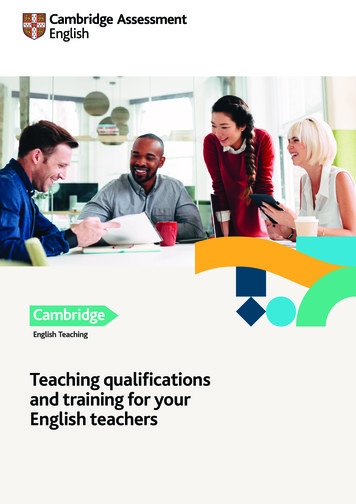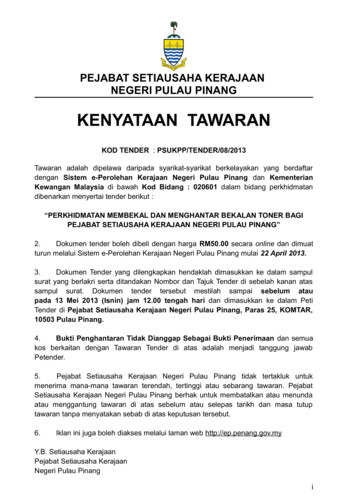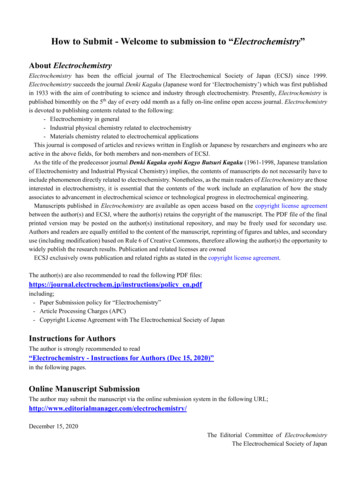Glossary Of Ed Terms - SEDL
GLOSSARY OF EDUCATION TERMSAcademic Performance Index (API) a statewide ranking of schools based on student testscores. Most schools have an API, a state ranking, and growth targets for the following year.American Recovery and Reinvestment Act (ARRA) federal funding to stimulate theeconomy that includes 90.9 billion for educationAccommodations changes in the way tests are designed or administered to respond to thespecial needs of students with disabilities and English learners (EL).Accountability people (e.g., students or teachers) or an organization (e.g., a school, schooldistrict, or state department of education) are held responsible for improving student achievementand are rewarded or sanctioned for their success or lack of success in doing so.Achievement gap observed difference on educational measures between the performance ofgroups of students, especially groups defined by gender, race/ethnicity, ability, andsocioeconomic status.Achievement test a test to measure a student's knowledge and skills.Adequate Yearly Progress (AYP) a state's measure of yearly progress toward achieving stateacademic standards. AYP is the minimum level of improvement that states, school districts, andschools must achieve each year as determined by a collection of performance measures that astate, its school districts, and subpopulations of students within its schools are supposed to meet ifthe state receives Title I federal funding.Adoption the chosen curriculum of a particular school.Advanced Placement (AP) a series of voluntary exams based on college-level courses taken inhigh school. High school students who do well on one or more of these exams have theopportunity to earn credit, advanced placement, or both for college.Alignment the degree to which assessments, curriculum, instruction, textbooks and otherinstructional materials, teacher preparation and professional development, and systems ofaccountability all reflect and reinforce educational objectives and standards.Alternative assessments ways, such as oral reports, projects, performances, experiments, andclass participation, to get information about what students know and where they need help.Annual Measurable Objective (AMO) the annual target for the percentage of students whosetest scores must be proficient or above in English/language arts and mathematics.Copyright 2010 by SEDL. All rights reserved. No part of this document may be reproduced or transmitted in any form or byany means, electronic or mechanical, including photocopy, recording, or any information storage and retrieval system, withoutpermission in writing from SEDL or by submitting an online copyright request form at www.sedl.org/about/copyright request.htmlUsers may need to secure additional permissions from copyright holders whose work SEDL included after obtaining permission asnoted to reproduce or adapt for this document.4700 MUELLER BLVD., AUSTIN, TX 78723 800-476-6861 www.sedl.org
Glossary of Education TermsAssessment teacher-made tests, standardized tests, or tests from textbook companies that areused to evaluate student performance.At-risk student students may be labeled at risk if they are not succeeding in school based oninformation gathered from test scores, attendance, or discipline problems.Average class size the number of students in classes divided by the number of classes. Becausesome teachers, such as reading specialists, have assignments outside the regular classroom, theaverage class size is usually larger than the pupil-teacher ratio.Average daily attendance (ADA) the total number of days of student attendance divided bythe total number of days in the regular school year. ADA is often lower than enrollment due tosuch factors as transiency, dropouts, and illness. A school district's funding is generally based onits ADA.Benchmarks a detailed description of a specific level of student achievement expected ofstudents at particular ages, grades, or developmental levels; also academic goals set for each gradelevel.Bilingual education a school program for students whose first language is not English or whohave limited English skills; includes Dual Language Education, English as a Second Language,and Immersion Education.Block scheduling instead of traditional 40- to 50-minute periods, block scheduling allows forperiods of more than an hour, often 90 minutes, so that teachers can accomplish more during aclass session. It also allows for teamwork across subject areas in some schools.Bond measure a method of borrowing that school districts use to pay for construction orrenovation projects, requiring a majority vote to pass. Property owners repay the principal andinterest.Categorical aid funds from the state or federal government granted to qualifying schools ordistricts for specific children with special needs, certain programs, or special purposes. In general,schools or districts must spend the money for the specific purpose. All districts receive categoricalaid in varying amounts in addition to general education program funds.Certificated/credentialed teachers those required by the state to hold licenses/credentials,including full-time, part-time, substitute, or temporary teachers. A teacher who has not yetacquired a certificate/credential (i.e., a state-issued license certifying that he/she has completedthe necessary basic training courses and passed the teacher exam) but has an emergency permit ora waiver to teach in the classroom is also included.Charter schools publicly funded schools that are generally exempt from many state laws andregulations for school districts. They are run by groups of teachers, parents, and/or foundations.Classified employees school employees not required to hold teaching credentials, such as busdrivers, secretaries, custodians, instructional aides, and some management personnel.SEDL Presentation at the 114th National PTA Convention and Exhibition2
Glossary of Education TermsClosed campus this usually indicates a school has one point of entry and a sign-in procedure assafety measures. It also refers to a high school that does not allow students to leave the campusfor lunch or does not allow students to come and go without permission during the school day.Cluster to place small groups of students together for instruction.Community-based learning students, faculty, administrators, and community membersworking together to create new learning opportunities within local communities but generallyoutside traditional learning institutions.Comparable growth subgroups of students in a school must improve their scores onstandardized tests. They are expected to achieve 80 percent of the predominant student group'starget, which is known as comparable growth.Content standards standards that describe what students should know and be able to do in coreacademic subjects at each grade level.Continuous improvement an ongoing effort to improve student and school outcomes,including processes that are constantly evaluated and enhanced in the light of their efficiency,effectiveness, and flexibility.Cooperative learning a teaching method in which students of differing abilities work togetherto complete an assignment. Each student has a specific responsibility within the group, butreceives a common grade.Core academics required subjects—usually English (language arts), math, history (socialstudies), and science.Criterion-referenced test a test that measures how well a student has learned a specific bodyof knowledge and skills. The goal is typically to have every student attain a passing mark, not tocompare students to each other.Curriculum the courses of study offered by a school or district. States develop a set ofstandards that are intended to guide curriculum and instruction. Decisions about schoolcurriculum are generally the responsibility of the local school board.Data-based decision making using evidence, and not intuition, to inform determinations. Thisincludes using data that are systematically gathered on a regular basis and other additionalinformation when planning, implementing, and reporting activities often to help improve thesuccess of students and schools.Differentiated instruction (also referred to as "individualized" or "customized" instruction) thecurriculum offers several different learning experiences within one lesson to meet students' variedneeds or learning styles, e.g. using different teaching methods for students with learningdisabilities.SEDL Presentation at the 114th National PTA Convention and Exhibition3
Glossary of Education TermsDisaggregated data the presentation of data broken into segments of the student populationinstead of the entire enrollment. Typical segments include students who are economicallydisadvantaged, from racial or ethnic minority groups, have disabilities, or have limited Englishfluency. Disaggregated data allows parents and teachers to see how each student group isperforming in a school.Elementary and Secondary Education Act (ESEA) a federal statute that funds primary andsecondary education, including many Title programs, performance guidelines, and fundingstipulations (known as No Child Left Behind under President Bush and awaiting authorizationunder President Obama).English learner a student who is not proficient enough in the English language to succeed inthe school's regular instructional programs and who qualifies for extra help. (Also can be referredto as Limited English Proficient/LEP.)Enrichment additional courses outside those required for graduation.Formative assessment any form of assessment used by an educator to evaluate students'knowledge and understanding of particular content and then to adjust instructional practicesaccordingly toward improving student achievement in that area.Free/reduced-price meals a federal program that provides food for students from low-incomefamilies.General fund accounting term used by the state and school districts to differentiate generalrevenues and expenditures from funds for specific uses.Highly qualified teacher a teacher who has obtained full state teacher certification or haspassed the state teacher licensing examination and holds a license to teach in the state; holds aminimum of a bachelor’s degree; and has demonstrated subject area competence in each of theacademic subjects in which the teacher teaches.Inclusion (or mainstreaming) placing students with disabilities in regular classrooms.Individual Education Program (IEP) a written plan created for a student with learningdisabilities by the student's teachers, parents or guardians, the school administrator, and otherinterested parties. The plan is tailored to the student's specific needs and abilities, and outlinesgoals for the student to reach. The IEP should be reviewed at least once a year.Instructional minutes the amount of time the state requires teachers to spend providinginstruction in each subject area.Integrated curriculum using a single theme to teach a variety of subjects. It also refers to aninterdisciplinary curriculum, which combines several school subjects into one project.SEDL Presentation at the 114th National PTA Convention and Exhibition4
Glossary of Education TermsInternational Baccalaureate (IB) a rigorous college preparation course of study that leads toexaminations for highly motivated high school students. Students can earn college credit frommany universities if their exam scores are high enough.Intervention strategies or processes to address specific student learning needs or whole schoolimprovement, i.e., before-school or afterschool programs or materials.Investing in Innovation Fund (i3) competitive grant funding for LEAs, nonprofit inpartnership with LEAs or consortium of schools to expand the implementation of, and investmentin, innovative practices demonstrated to impact student ach/growth, closing achievement gaps,decreasing dropout rates, increasing high school graduation rates, or increasing college enrollmentand completion rates.Language arts another term for English curriculum, focused on reading, speaking, listening,and writing skills.Magnet school a school that focuses on a particular discipline, such as science, math, arts, orcomputer science. It is commonly designed to recruit students from other parts of a school district.Manipulatives three-dimensional teaching aids and visuals that teachers use to help studentswith math concepts. Typical tools include counting beads or bars, base ten blocks, shapes,fraction parts, and rulers.Minimum day a shortened school day that allows teachers to meet and work together.National Blue Ribbon Award this award honors public and private K–12 schools that areacademically superior or that demonstrate dramatic gains in student achievement.Norm-referenced assessment (standardized test) an assessment in which an individual orgroup's performance is compared with a larger group. Usually the larger group is representative ofa cross-section of all US students.Percentile ranks a way to compare a given child, class, school, or district to a national norm byusing the percentage of scores in its frequency distribution which are lower than it.Portfolio a collection of various samples of a student’s work that can include writing samples,examples of math problems, and results of science experiments.Professional development programs that help teachers or administrators acquire the knowledgeand skills they need to perform their jobs successfully.Proficiency mastery or ability to do something at grade level. A state goal is for all students toscore at least a basic level on state achievement tests.SEDL Presentation at the 114th National PTA Convention and Exhibition5
Glossary of Education TermsProgram Improvement (PI) a multistep plan to improve the performance of students inschools that receive federal Title I funds that did not make adequate yearly progress for two yearsin a row. Steps in PI can include a revised school plan, professional development, tutoring forsome students, transfer to another school with free transportation, and, at the end of five years,significant restructuring.Pull-out programs students receive instruction in small groups outside of the classroom.Pupil-teacher ratio the total student enrollment divided by the number of full-time equivalentteachers. The pupil-teacher ratio is the most common statistic for comparing data across states; itis usually smaller than average class size because some teachers work outside the classroom.Resource teachers and specialists teachers who work with special education students byassisting them in regular classes or pulling them out of class for extra help.Rubric a grading or scoring system that lists the criteria to be met in a piece of work. A rubricalso describes levels of quality for each of the criteria. These levels of performance may bewritten as different ratings (e.g., Excellent, Good, Needs Improvement) or as numerical scores(e.g., 4, 3, 2, 1).Safe harbor an alternate method for a school to meet AMO if it shows progress in improvingstudents achievement. The state, school districts, and schools may still make AYP if a subgroupfails to reach its proficiency performance targets.School report card an annual disclosure report for parents and the public produced by a schoolthat generally presents student achievement, test scores, teacher credentials, dropout rates, classsizes, resources, and more.School Improvement Program (SIP) a tool to improve instruction, services, schoolenvironment and organization at school sites according to plans often developed by school sitecouncils.School site council a group of teachers, parents, administrators, and interested communitymembers who work together to develop and monitor a school's improvement plan. It is a legallyrequired decision-making body for any school receiving federal funds.Scientifically based research research that involves the application of rigorous, systemic, andobjective procedures to obtain reliable and valid knowledge relevant to educational activities andprograms.Socioeconomically disadvantaged students who participate in the federally funded free/reduced price meal program because of low family income or whose parents do not have a highschool diploma.Special education special instruction provided for students with educational or physicaldisabilities, tailored to each student's needs and learning style.SEDL Presentation at the 114th National PTA Convention and Exhibition6
Glossary of Education TermsStaff development days days set aside in the school calendar for teacher training. School is notgenerally held on these days.Standardized test (standards-referenced tests or standards-based assessments ) a test that is inthe same format for all who take it. It often relies on multiple-choice questions and the testingconditions—including instructions, time limits, and scoring rubrics—are the same for all students,though sometimes accommodations on time limits and instructions are made for students withdisabilities.Team teaching a teaching method in which two or more teachers teach the same subjects ortheme. The teachers may alternate teaching the entire group or divide the group into sections orclasses that rotate between the teachers.Tenure a system of due process and employment guarantee for teachers.Thematic units a unit of study that has lessons focused on a specific theme, sometimescovering all core subject areas. It is often used as an alternative approach to teaching history orsocial studies chronologically.Title I a federal program that provides supplemental funds for at-risk and low-income studentsto ensure they have a fair, equal, and significant opportunity to obtain a high quality educationand reach, at minimum, proficiency on state academic achievement standards and assessments.Tracking a common instructional practice of organizing student in groups based on theiracademic skills. Tracking allows a teacher to provide the same level of instruction to the entiregroup.Year-round education a modified school calendar that gives students short breaks throughoutthe year, instead of a traditional three-month summer break. Year-round calendars vary,sometimes within the same school district. Some schools use the staggered schedule to relieveovercrowding, while others believe the three-month break allows students to forget much of thematerial covered in the previous year.Sources for the definitions above include: Ed-Data, Ed Source, School Wise Press, SEDL and Wikipedia.SEDL Presentation at the 114th National PTA Convention and Exhibition7
Glossary of Education Terms SEDL Presentation at the 114th National PTA Convention and Exhibition 2 Assessment teacher-made tests, standardized tests, or tests from textbook companies that are used to evaluate student performance. At-risk student students may be labeled at risk if they are not succeeding in school based on information
ITIL Glossary of Terms, Definitions and Acronyms in Hungarian, V3.1.24.h2.5, 24 February 2008, prepared by itSMF Hungary 1 ITIL V3 Hungarian Glossary Notes: 1. This ITIL V3 Hungarian Glossary (internal version: 2.5) is the itSMF Hungary's official translation of ITIL V3 Glossary of Terms, Definitions and Acronyms (version 3.1.24). 2. The Hungarian ITIL Terms have a relatively long .
IEEE Std 729-1983, IEEE Standard Glossary of Software Engineering Terminology (ANSI) L3I.l It increases the number of terms from approximately 500 to 1300, and updates or refines the definitions of many terms included in the initial glossary. A few terms that were included in the initial glossary have
nd!Learning! - SEDL . teachers.!!
by the National Partnership for Quality Afterschool Learning (the National Partnership), which is led by SEDL, and commissioned by the U.S. Department of Education (USDE). This report describes SEDL's evaluation approach to the grantee selection process and the methods used to develop case profiles of 12 21st CCLCs identified as promising.
Mathematics — Glossary Page 1 – 2014–15 NYSAA Frameworks Glossary – Mathematics Mathematics Glossary A Mathematics Toolkit, i
This Glossary represents an initial step in a process of harmonising health and wellness terms within the consumer goods industry. The Glossary is intended to complement existing definitions. The success of the glossary is dependent on individuals and companies using the terms and definit
version of the PPRI Glossary was drafted, revised after a consultation process with the PPRI network and published in 2006. Since terminology is constantly changing, the authors of the PPRI glossary invited experts and the public to provide feed-back on the glossary, make suggestions for changes and propose new terms.
Ratio 104 121 143 165 195 231 273 319 377 473 559 649 731 841 1003 1247 1479 1849 2065 2537 3045 3481 4437 5133 6177 7569 50 Hz 60 Hz 13.9 12.0 10.1 8.79 7.44 6.28 5.31 4.55 3.85 3.07 2.59 2.23 1.98 1.72 1.45 1.16 0.98 0.754 0.702 0.572 0.476 0.417 0.327 0.282 0.235 0.192























